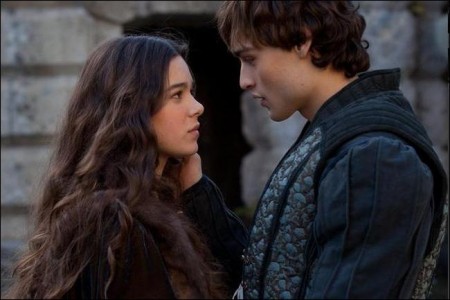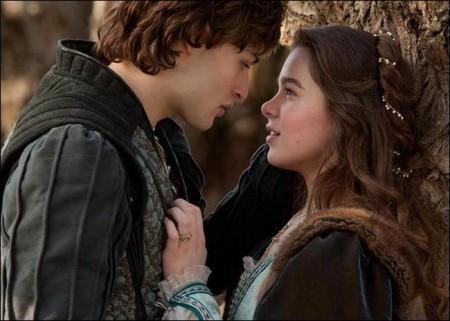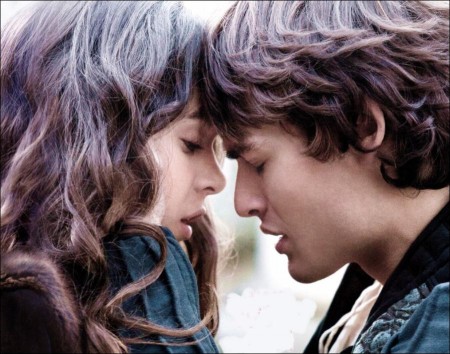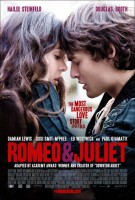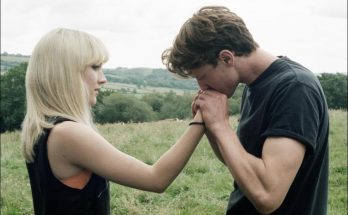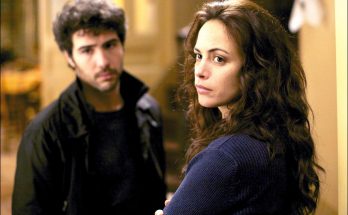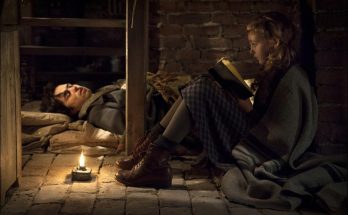Taglines: The most dangerous love story ever told.
The families of Montague and Capulet use any excuse to publicly fight in the streets of Verona, drawing a strict rebuke from the Prince (Stellan Skarsgård). But young Romeo (Douglas Booth) of the Montagues is not interested – he is far too in love with Rosaline, a cousin to the Capulets, a romance which his cousin Benvolio (Kodi Smit-McPhee) urges him not to pursue. But that night, there is to be a masked celebration at the Capulet estate, and Romeo manages to secure an invitation. The Capulet household prepares for the event, where Lord and Lady Capulet (Damian Lewis, Natascha McElhone) hope that their daughter Juliet (Hailee Steinfeld) will accept the advances of young Count Paris (Tom Wisdom). A free spirit little interested in romance, Juliet seems more interested in bantering with her nurse (Lesley Manville) than listening to her parents.
At the ball, Romeo instantly forgets his feelings for Rosaline when he spies Juliet; she is likewise struck dumb when she sees Romeo. They dance briefly, noted by Juliet’s cousin Tybalt (Ed Westwick), who is told by Lord Capulet to let them be and not start trouble. Later, Romeo and Juliet are dismayed to learn that their new loves are of the rival family; undaunted, Romeo spies Juliet on her balcony and boldly declares his love for her.
About the Production (2013)
He is impetuous and emotional, ruled by his heart. She is a thoughtful ingénue, new to romance. And they are madly in love. Their parents and kinsmen would disapprove – if they knew. But they cannot – their families are bitter, ancient enemies, and would separate them forever if they had any inkling of the budding passion. His name is Romeo and hers is Juliet. The lengths they go to for love will require schemes and secrecy, will turn friend against friend, cousin against cousin. It will lead to violence and death – and, ultimately, to reconciliation.
Sometime between 1591 and 1595, William Shakespeare wrote what would become one of his most celebrated and beloved plays: “Romeo and Juliet.” This tragic tale of “a pair of star-crossed lovers” has captured the hearts and imaginations of audiences ever since. While the iconic teens’ ill-fated love affair has played out on stage, television and movies, it has been over 40 years since a feature film returned the story to its original setting in Verona, Italy.
Academy Award-winning screenwriter Julian Fellowes, director Carlo Carlei and Swarovski Entertainment and Amber Entertainment aim to rectify that with this latest screen adaptation of the play, filmed on location, starring Hailee Steinfeld and Douglas Booth as the title characters, and featuring an international, all-star cast of actors as their friends and relatives, members of opposing houses of Montague and Capulet.
The latest version of “Romeo and Juliet” began with producer Ileen Maisel, who felt that the current generation had not been exposed to a more traditional, romantic vision of the play and might enjoy sumptuous locations, costumes and production design, along with the timeless tale of young love, deception, intrigue, death and redemption.
While Renaissance-era English and iambic pentameter can be daunting, Maisel believed the story has contemporary resonance – the opposing young Montague and Capulet boys are akin to rival gangs, for instance; and Romeo and Juliet carry on an illicit relationship, in direct defiance of their parents, something every teenager can understand. Maisel wanted someone who could update Shakespeare’s language and story while staying true to its poetic cadence and compelling plot lines. She turned to Julian Fellowes, who, with the acclaimed feature “Gosford Park” and his recent television series “Downton Abbey,” has experience adapting dense, multi-character, period dramas for modern sensibilities.
“Ileen thought that modern audiences hadn’t seen a classic presentation of the play on film in a long time,” Fellowes says. “Medieval Italy, velvet, silk and damask costumes, climbing roses, the beautiful, Italian architecture, that sort of thing. She thought the story was timely but also that the play needed to be accessible for the new generation in a simpler, more straight-forward way. Also, the play is three hours long and we needed to work in the timescale of modern films, so the narrative had to be more concise. There have been good film versions – notably Baz Luhrmann’s, which I thought was marvelous – but that was set against a contemporary background. There hasn’t been a more traditional ‘Romeo and Juliet’ since Franco Zefirelli’s in 1968,” Fellowes says.
A Short History of Romeo and Juliet on Film (2013)
One of Shakespeare’s so-called “black” plays – because any company putting on the show will be guaranteed to be “in the black” (turning a profit) – it’s no surprise that “Romeo and Juliet” has proved to be irresistible for filmmakers since the earliest days of the motion picture. With iconic moments such as the balcony scene, the deaths of Tybalt and Mercutio, and taunting of the Nurse, and the final tragic moments in the crypt, the story speaks as much in visual language as it does in Shakespeare’s soaring, heartbreaking verse. The earliest record of the play on film is a French version from around 1900 – a mere four years after the public exhibition of films began.
Early Hollywood also embraced the work. “Perils of Pauline” hero Paul Panzer played Romeo in a 1908 version opposite a young Canadian named Florence Lawrence: Lawrence was unbilled, but her success in that role and others eventually lead her to abandon her contract with Biograph and become the first nationally publicized “movie star” a couple of years later. In 1916, Metro Pictures (with a version starring matinee idol Francis X. Bushman) raced to get their version of the classic to the screen three days before the Fox version (with smoky Theda Bara as Juliet), with spies from both studios apparently engaging in corporate espionage to bring secrets of production from one set to another.
Since then, productions of “Romeo and Juliet” have tended to be high-profile events worthy of the screen’s greatest talent. In 1936, MGM, the “Tiffany” of the movie studios, hired George Cukor to direct an all-star version of the film, with reigning MGM queen Norma Shearer and A-list British import Leslie Howard as the title lovers. Never mind that Shearer was 34 years old and Howard 43 at the time; with stage and screen legend John Barrymore as Mercutio and notorious “bad guy” Basil Rathbone as Tybalt, the film received four Academy Award nominations.
The 1954 UK version also earned international acclaim, with young Laurence Harvey (“The Manchurian Candidate”) starring opposite unknown Susan Shentall – in her only screen role. With a stable of renowned character actors like Flora Robson, Mervyn Johns, John Gielgud, and Sebastian Cabot in supporting roles, the Renato Castellani- directed version won the Golden Lion at the Venice Film Festival and was named Best Foreign Film by the National Board of Review.
Perhaps the best-known version of the film to date is the 1968 Itailan/UK co-production directed by Franco Zeffirelli. Featuring two young actors who were very close to the age of the characters, audiences flocked to see Olivia Hussey (15 when the movie was made) and Leonard Whiting (17) as the title characters. In the more modern era, the young lovers’ passion was most evident in bedroom scenes that featured glimpses of a nude Hussey: eventually, the scenes generated controversy when Hussey was not allowed to attend the premiere of the film because she was underage, even though she was the one who appeared nude. Still, audiences were probably just as much enthralled by the lush location shooting, period costumes, outstanding supporting performances by Michael York (a cold and villainous Tybalt) and Milo O’Shea (a sympathetic if bumbling Friar Laurence),and the haunting “Love Theme” (“What is a youth, what is a maid…”) featured throughout the film. The film earned Academy Awards for Best Cinematography and Best Costume Design, and went on to earn nearly $40 million on a budget of less than $1 million.
More recently, the story was taken up by director Baz Luhrmann in 1996 in “Romeo + Juliet,” starring then-youthful sensations Leonardo DiCaprio and Claire Danes. Though well-received and well-regarded, Lurhmann’s film drew some criticism for resetting the action in a contemporary beach community meant to resemble Miami, choosing to represent the swordfights as gunplay, and often deliberately highlighting anachronistic elements in both the visual design and soundtrack. Perhaps most significantly, the famous “balcony” scene became a moonlight swim with the two lovers eagerly embracing underwater as opposed to over a suspended trellis. Still, the film earned acclaim from audiences young and old who appreciated the contemporary interpretation, and helped solidify the young Luhrmann’s career in anticipation of his widely praised “Moulin Rouge” (2001).
Even when it is not called “Romeo and Juliet,” the story of Verona’s star-crossed lovers has helped inspire filmmakers and artists. Several ballets are inspired by the play, and every tenth grader knows that the legendary musical “West Side Story” transplants the basic elements of the story to the streets of New York in the 1950s. The Oscar-winning “Shakespeare in Love” centers around the first production of the play in Elizabethan England (a highly fictionalized, but nonetheless enchanting rendering); the play and film “Romanoff and Juliet” imagines the lovers in the Cold War; the imaginative “Romeo Must Die” with Jet Li is a martial-arts version of the familiar story; and most recently, the animated comedy “Gnomeo and Juliet” imagines the lovers as the garden gnomes belonging to two feuding neighbors. Regardless of the filmmakers’ unique take, the presence of the story throughout film history is a testament to the story’s enduring appeal and ability to entertain in many ways, shapes and forms.
Romeo and Juliet (2013)
Directed by: Carlo Carlei
Starring: Hailee Steinfeld, Douglas Booth, Holly Hunter, Ed Westwick, Kodi Smit-McPhee, Paul Giamatti
Screenplay by: Julian Fellowes
Production Design by: Tonino Zera
Cinematography by: David Tattersall
Film Editing by: Peter Honess
Costume Design by: Carlo Poggioli
Set Decoration by: Maurizio Leonardi, Christina Onori
Music by: Abel Korzeniowski
MPAA Rating: PG-13 for some violence and thematic elements.
Studio: Relativity Media
Release Date: October 11, 2013
Visits: 48
